
The Solar Eclipse Left Crescent-Shaped Damage On A Woman's Eye, A New Study Shows
I think many of us can agree that one of the best and most exciting experiences of 2017 was the eclipse. All across America — as well as parts of South America, Europe, and Africa — people got ready for either a total or partial eclipse of the sun by checking their local viewing time and buying some of those special eclipse glasses. Yes, it was said to be imperative that people wear said glasses, which comply with an international safety standard to help people safely enjoy the view without eye damage from the solar eclipse. And really, the insistence on wearing those funny-looking glasses proved to be no laughing matter.
In fact, new optic technology has recently been developed, and it's able to see the eye damage from a sustained gaze at that naturally awesome event without the proper protection. This technology, called adaptive optics, was previously used, in part, to to reduce the blurred light from stars so the star itself could be seen more clearly.
Now, the technology is helping doctors examine people's eyes on a super specific, cellular level. Unfortunately, for 26-year-old Nia Payne, this means experts have been able to detect some serious damage to her eyes after she looked directly at the solar eclipse on Aug. 21, 2017.
Payne attempted to look up at the eclipse in Staten Island, New York, and later ended up in the ER with a "crescent shape" blocking her vision in the center of her left eye. The woman didn't have any glasses to shield her eyes that day, as they were quickly sold out and distributed among the excited, fellow viewers around her.
Payne told CNN that she did manage to borrow glasses from someone later, after which point she gazed up at the eclipse for about 15 to 20 seconds while wearing them.
She recalled that the sun seemed quite bright as she looked up at the sky, but at the time, she wasn't really alarmed, nor did she believe she'd endangered herself or her vision.
By the time she realized something was wrong, at first, her friends and family — and later on, the first ER she visited — didn't take her complaints seriously. Eventually, though, after being referred to the New York Eye and Ear Infirmary of Mount Sinai, Payne was diagnosed with something called solar retinopathy, which means injury of the retinal tissues as a result of sustained, direct solar exposure.
Unfortunately, there is no cure or treatment for this type of eye damage.
Payne has sustained permanent, crescent-shaped damage to her left eye, as well as some less intense damage to her right eye.
Avnish Deobhakta, assistant professor of ophthalmology at Mount Sinai, and co-author of the study that helped develop the technology able to detect this sort of injury, told The Washington Post that, because the damage to Payne's retina looked like "mirror images" of the eclipse, "it proved that scientists’ 'intuitions were correct' in their theories of how the sun damages the eye."
Yes, you read that correctly. The damage the doctors found on Payne's eye matched the image that they had first asked her to draw of what she saw on her eye: the shape of the eclipse.
Before this report, there had been no previously published research about the specific damage that can be done to the eye as a result of looking directly at a solar eclipse. In Payne's case, the researchers looked specifically at what's called the photoreceptor layer of her retina. Deobhakta told The Washington Post that this is the part of the eye that “takes in the sun’s light and converts it to electrical energy so our brains can make sense of light."
This new technology that allows researchers to see this kind of damage at a structural level could be the first step toward trying to treat the damage. One can only hope that researchers will be able to create an effective treatment within Payne's lifetime, but as of now, the injury is, sadly, permanent.
As for the rest of us, let's all make sure that when the next total eclipse in North America comes about on April 8, 2024, we're 100 percent prepared with safe, protective glasses.